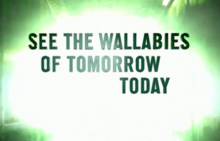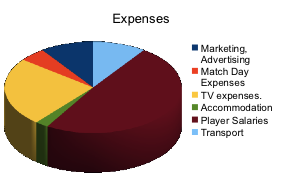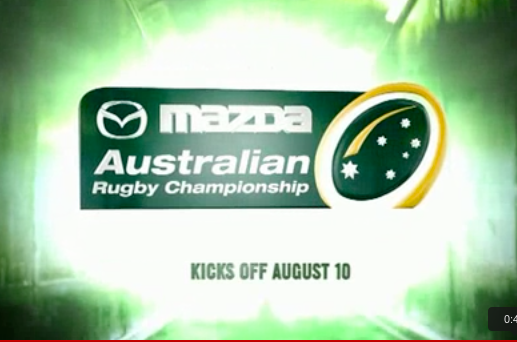For some time this website has been campaigning for a 3rd tier and there has been much discussion about how it would help develop players. It’s well known that the ARU has tried this before, with the ill fated Australian Rugby Championship (ARC) which folded after one year and also the Australian Rugby Shield. I’m going to put my cock on the block and try to come up with a way it might work if done differently, plus some idea of how much it would cost.
Where the ARC went wrong.

To not learn from history is to repeat it, so we need to understand where we went wrong before and try something else. The ARC folded for a number of reasons. The teams in it were franchises which were unable to make a connection with fans in the areas they represented and the clubs weren’t all too pleased about having their best players taken. The ARU will tell you how hard it is to start a super franchise from scratch, so why they went for several in a third tier at once is a good question. The result were average crowds of about 2800 for the ARC and thus lower than needed ticket receipts.
There was also poor strategic execution. It was launched at the same time, more or less, as the RWC which was a shit idea for 2 reasons. One, the fans are all thinking about the big one in France and therefore not ready for a domestic competition as there was no momentum. Two, the ARU used to take a huge financial hit every 4 years, so it was no position to find 8 million in 2008 to keep the ARC alive when not even 3000 were turning up to see the games. All very predictable, you would think.
Big John was right to kill the ARC, from a strictly financial view but now the ARU is going to get between 12 and 17 million from the IRB to cover the losses it was taking as a result of the RWC. To give credit where it’s due, John has put the ARU on a good financial footing. It’s now time to make investments to find players to fill the 2 super franchises the ARU has over the recent years to put us on a better playing footing.
The ARU has acknowledged that it needs to time to get enough players to make all 5 super sides competitive, so a third tier, by definition is a must. So we have the motivation and the means.
Some holes may be found in my numbers as I don’t have insider knowledge but the fact is the New Zealanders allocate 490 dollars of their revenue per player and we manage 279. They are world champions and we just got beaten by Scotland. Again.
So how could it be done?
Firstly it needs a firm, long term commitment from the ARU. A third tier needs to be seen as a strategic decision to grow players, not make cash profits. Strategic decisions take time to implement and they cost money but if they are left too late, the cost is often more.
It means it has to be accepted that the ARU is going to have to put money into a third tier for some time to fund it. But, to repeat, a big cash injection has been received so let’s see it used.
Building on What We Have.
A third tier also needs to be build on what we have. The franchises might make things nice and simple for the ARU to control but they don’t have the history of a Randwick or a Brothers. The national competition must build on that so it’s the clubs who take part, not faceless franchises controlled by the ARU’s own faceless men. The administrators therefore need to grow up, remember who they work for (us who buy tickets) and start cooperating.
Finally, the ARU can’t think too big to start with. The majority of the players are not likely to be paid full-time at first. It’s within living memory that a good percentage of top mungo players were only semi-professional. A 10 team competition with 250 to 300 pro players is not gonna fly at the moment.
My league would work like soccer’s champion’s league and also the Heineken Cup. If your team finishes in the top 3, you get in to the big time. To avoid the punter’s indifference to the franchises, the top 3 sides from the Shute Shield and the Brisbane comp go through and 2 from Canberra. Due to the smaller markets, Melbourne and Perth get to field a side with their super players as a matter of course. I said it’s an investment and that’s the price – it’s tougher for Sydney and Brisbane sides but they have a bigger fan base.
The annual rugby season in Australia would look something like the chart below.
The national comp, (shown in green) runs at the same time as the ITM and Currie cups do and the aim is a progression through the season. It also provides a useful step down for injured / out of form super & test players. The June and July end of the city competitions are also more serious as the top sides have something to aim for – qualification for the national champs later in the year. In my view, this scores big time over the way the ARC was built.
Keeping it affordable.
In the national competition, sides play each other once a season. I’m trying to keep things cheap and the travel is a factor. The top 4 on the log at the end of the round robin phase play semis and then a final to be called National Champs. So each side plays 8 national level games and perhaps 2 more finals. Throw in a bye and that makes 11 weeks of footy from August to October. That takes us up to the winter wallaby tour.
How to pay for it? Well, that’s the big issue. I’ve kept this proposal to one where teams play each other only once and, like super rugby now, one where not all sides play each other in a given season, for cost reasons.
 Based on some figures available from the days of the ARC, the expenses of the competition could breakdown something like the pie chart to the right.
Based on some figures available from the days of the ARC, the expenses of the competition could breakdown something like the pie chart to the right.
I’ve given the ARU an extra 500,000 to work out a deal to extend the TV coverage they have with the ABC. I’ll admit I’m not familiar with the inner workings of broadcasting deals but for that much I reckon you could watch a match of the day in Sydney and also Brisbane plus get a review show on the weekend.
Not all the players are going to be full time pros, just as not every player in the ITM cup is, so players get 500 a game, and like the old ARC, I assume there are 250 of them. To keep things cheaper still, 171 super players who are already being paid don’t figure into this and I have allowed for 35 Wallabies not to be there. This means we need 134 third tier semi-pro players (but who are not now contracted to a super side) who will get 500 a game. A total of 1.2 million, or thereabouts as I threw in a couple of hundred grand for coaches and physios as well.
I did a lot of checking of Jet Star’s and Virgin Blue’s websites for flights and if they are booked far enough in advance, flights and coaches between grounds can be done for a bit less than 180,000 a season.
The remaining expenses (match day fees, advertising and player insurance) total 350,000. I estimated these by reading annual reports where I could get them and checking how much player insurance is.
Some Money Comes in.
 I assumed average crowds of 1500. The ARC managed about 2800, so I am being pretty cautious here and it gives ticket sales of 600,000. at 10 dollars a ticket for 40 games. I believe the ARU should be family friendly and let kids under 15 in free. I allowed for a total of 50,000 in beer and sanger sales and another 30,000 in merchandise. Both pretty conservative figures in my view. The pie chart shows my estimates. The biggest slice is the money we need to prise from the misers at the ARU.
I assumed average crowds of 1500. The ARC managed about 2800, so I am being pretty cautious here and it gives ticket sales of 600,000. at 10 dollars a ticket for 40 games. I believe the ARU should be family friendly and let kids under 15 in free. I allowed for a total of 50,000 in beer and sanger sales and another 30,000 in merchandise. Both pretty conservative figures in my view. The pie chart shows my estimates. The biggest slice is the money we need to prise from the misers at the ARU.
The important figure that will cause debate is 1.4 million ARU top up. To my calculations, on a modest budget, with semi pro players, weak crowds, poor sponsorship and so on, the ARU would need to chip in that much to make up the difference between income and expenses of the new national championship. Given the ARC lost 4 million in its first year and was expected to double that in its second year, this is pretty reasonable.
Got any better ideas? Let’s hear them. Spot any errors, great. Just don’t tell me we can keep going like this forever.



